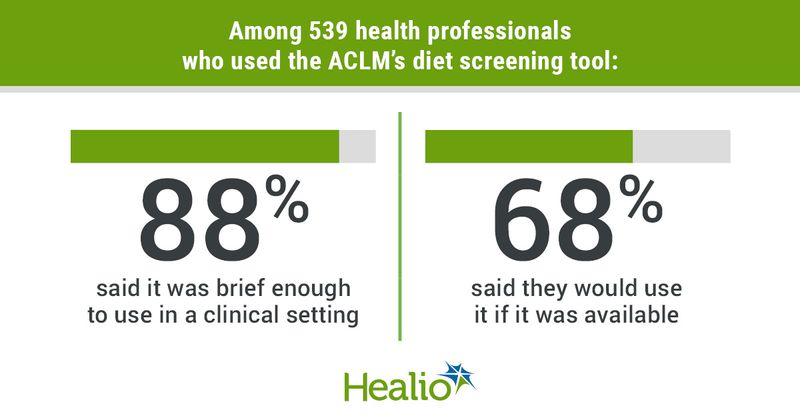Key takeaways:
- The screening tool is brief, taking only 3 to 4 minutes to complete.
- An expert said the tool allows clinicians to look at a patient’s diet “on the granular level” while also providing an “overall picture.”
The American College of Lifestyle Medicine, or ACLM, announced the release of a simple diet screening tool that captures a patient’s dietary pattern, allowing clinicians to implement a “food as medicine” approach in practice.
“While there are other screeners that exist for specific populations, we are unaware of any single tool that is as flexible to a wide variety of patient populations such as the ACLM Diet Screener,” Susan Friedman, MD, MPH, DipABLM, FACLM, a professor of medicine at the University of Rochester, said in a press release. “Our hope is that clinicians will find this tool helpful for many different patients, even if their practice is very busy.”
The free-to-use, 27-item screening tool — available on the ACLM’s website — was designed to help guide clinical conversations on nutrition, while also being brief enough to use during routine clinical visits, according to Friedman and colleagues, whose study on the development and initial pilot testing of the screening tool was published in Frontiers in Nutrition.
The screener features 20 questions on food consumption, six on beverages and one on nutrients and supplements. The developers grouped foods into categories, including leafy green vegetables; fruits; legumes; dishes made with meat, eggs or seafood; restaurant or takeout food; fast food; frozen meals; and fried foods.
After the screening is completed, the tool generates summary scores reflecting the proportion of whole plant food to total food consumption and the proportion of water to total beverage consumption. The score summaries can be formatted into pie charts to help patients visualize their dietary pattern.
Of the 539 health care professionals who Friedman and colleagues surveyed for their study, 73% said they discuss diet with all or most of their patients, but 80% reported facing barriers to assessing diet.
Overall, 88% of respondents believed that the screener was brief enough to use in clinical settings and 68% said they would use it if it was available.
Healio spoke with Friedman to discuss some of the tool’s features, its development process and more.
Healio: What kind of barriers are there when assessing diet?
Friedman: I think probably the biggest barrier is time. I would say most clinicians at this point have very limited time to spend with their patients and so [there is a need for] efficient tools to gather information when they can. There are also potential challenges with literacy and being able to participate in written questionnaires.
Healio: What are some features about the screening tool that stand out?
Friedman: I’m a lifestyle medicine physician and geriatrician … and I think ever since I’ve been practicing lifestyle medicine, I’ve wanted to have a tool that is efficient to use with patients to assess just how whole-food, plant-based their diet is because a whole-food, plant-based diet is the only diet that’s been shown to reverse heart disease and addresses a lot of other common chronic conditions as well.
One of the things the screener does is assess all the major food groups and then it gives information on the frequency of eating whole, plant-based foods. I think that’s important.
It’s very brief. On average, it took 3 to 4 minutes to complete the tool. One of the things that I think is a nice feature is that patients can complete it on their own. So, if they’re in the waiting room, they can fill it out and then have the discussion with the clinician when they see them.
While being comprehensive, the tool also provides consolidated printouts that allow for closer examination of the different components, so the clinician can have discussions about a specific piece, like if the patient is eating a lot of processed foods. They can look at a more granular level, but then they can also look at the overall picture.
Healio: How does it compare with other available screening tools?
Friedman: It’s the only one we are aware of that is both brief and asks questions about individual components and then can give an overall picture of how plant-based a person’s diet is.
Healio: What’s next in the development and assessment of the screening tool?
Friedman: This is really the first stage. It’s already been through a couple of different pilots in its development, but now that we have the tool that we think we’re going to be using, we’re going to be pilot testing it in clinical settings to evaluate the uptake and usability and to gather additional feedback on it, and then to validate it. As a screener tool, it gives an estimate, and so we’ll be validating it against the “gold standard” assessment in nutrition research — food records. We think it captures information well, but this will give us an idea of exactly how well it does capture that information.
References:
For more information:
Micaela Karlsen, PhD, MSPH, can be reached at mkarlsen@lifestylemedicine.org
